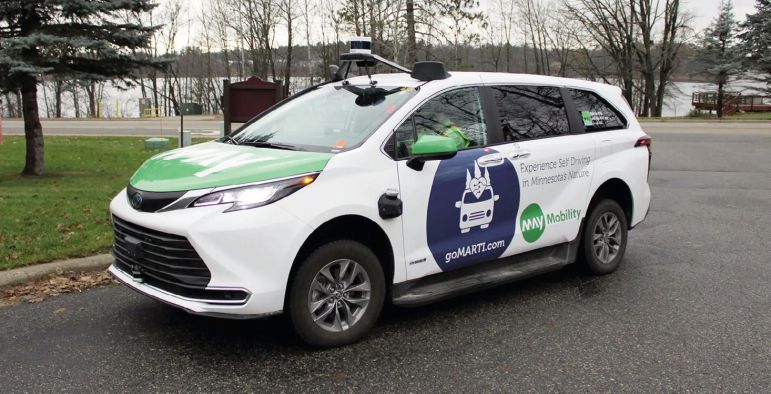WHAT'S HAPPENING
PEOPLE WITH DISABILITIES HOPE AUTONOMOUS VEHICLES DELIVER INDEPENDENCE
BY TONY LEYS
Myrna Peterson predicts self-driving vehicles will be a ticket out of isolation and loneliness for people like her, who live outside big cities and have disabilities that prevent them from driving.

THE ROAD AHEAD: One of the five self-driving vans now serving the northern Minnesota community of Grand Rapids. The vans are part of a program called "goMARTI," which stands for Minnesota's Autonomous Rural Transit Initiative.
Peterson, who has quadriplegia, is an enthusiastic participant in an unusual test of autonomous vehicles in this corner of northern Minnesota. She helped attract government funding to bring five self-driving vans to Grand Rapids, a city of 11,000 people in a region of pine and birch forests along the Mississippi River.
The project’s self-driving vans always have a human operator in the driver’s seat, poised to take over in complicated situations. But the computers are in control about 90% of the time, and they’ve given 5,000 rides since 2022 without any accidents, organizers say.
"It's been fun. I'm really sold on it," said Peterson, who used to rely on her power wheelchair to travel around town, even in winter.
Autonomous vehicles, which can drive themselves at least part of the time, are making news in urban areas, such as San Francisco, where extensive tests of the technology are underway.
Rural experiments have been set up in a few other states, including Iowa and Ohio. Peterson hopes the pilot projects help bring a day when fully autonomous cars and vans assist the estimated 25 million Americans whose travel is limited by disabilities.
Fully independent vehicles remain far from everyday options, as tech companies and automakers struggle to perfect the technology. Recently, for example, General Motors recalled all its self-driving cars after one struck and dragged a pedestrian who had been hit by another vehicle.
But Waymo, a corporate relative of Google, is forging ahead with fully autonomous taxi rides in multiple cities.
Peterson is among those who believe autonomous vehicles someday will become safer than human-driven models. "Look at how many times the lightbulb failed before it worked," she said.
Unlike many smaller towns, Grand Rapids has public buses and a taxi service. But Peterson said those options don't always work well, especially for people with disabilities. The autonomous vehicle program, known as goMARTI, which stands for Minnesota's Autonomous Rural Transit Initiative, offers a flexible alternative, she said. She hopes it eventually will ease a national shortage of drivers, which tends to be especially acute in rural regions.
The project is funded through the spring of 2027 with more than $13 million from federal, state, and local sources, much of it coming from the 2021 federal infrastructure bill.
The project's distinctive Toyota minivans are outfitted by a Michigan company, May Mobility, which is backed by the Japanese auto giant and other investors. Slogans painted on the side invite the public to "Experience Self Driving in Minnesota's Nature." The vans bristle with technology,
including cameras, radar, GPS, and laser sensors. Their computer systems constantly monitor surroundings and learn from situations they encounter, said Jon Dege, who helps manage the project for May Mobility.
Users arrange free rides via a smartphone app or the 211 social service telephone line.
On a recent chilly afternoon, a goMARTI van pulled up near Peterson's house. She soon emerged, bundled in a bright purple parka honoring her beloved Minnesota Vikings football team. She rolled her electric wheelchair to the van, up a ramp, and into the back. Van operator Mark Haase helped strap the wheelchair in, then climbed into the driver's seat for a demonstration.
As the van pulled onto the street, the steering wheel seemed to shudder, reflecting tiny adjustments the computer made. Haase kept his foot poised near the brake pedal and his hands cupped around the steering wheel, ready to take over if a complication came up. After moments when he needed to take control of the vehicle, he pressed a button telling the computer system to resume command. "It was weird at first, but it didn't take long to get used to it and trust the system," Haase said.